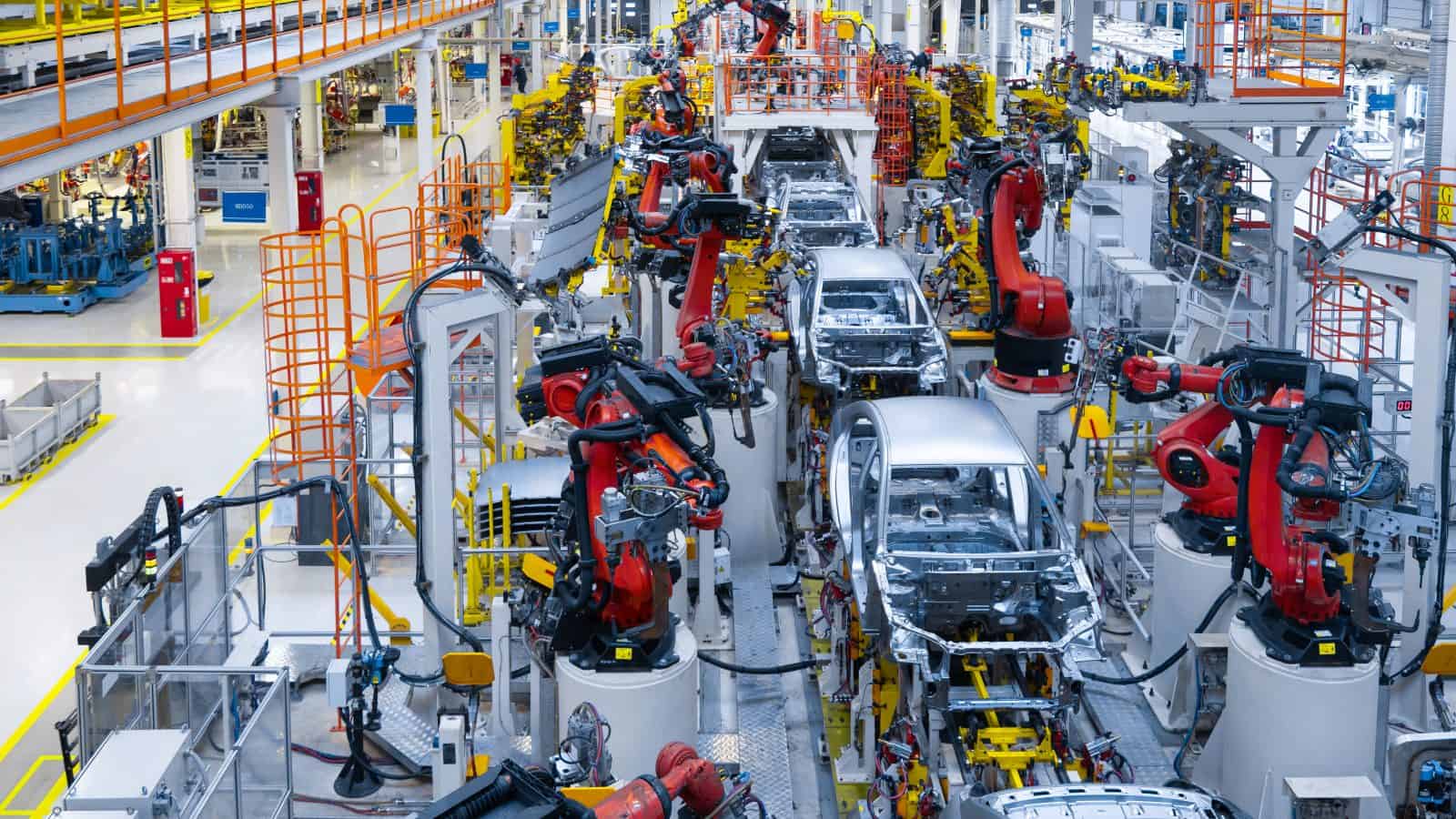AI Driven Solutions for Manufacturing Excellence
Thanks to the rising ease of adopting cutting-edge technologies like artificial intelligence, Internet of Things (IoT), big data analytics, and robotics, manufacturing is booming across the world. In the United States, for instance, a manufacturing boom has swept across the country in the last two and a half years, with the South and Mountain West having especially strong growth, according to Bureau of Labor Statistics (BLS) data1. The U.S. economy has added some 800,000 manufacturing jobs nationwide in just the last couple of years. In terms of numbers, Texas is the top state for new manufacturing jobs, with 86,000 new positions, from January 2021 to May 2023, according to BLS data. Next comes California with 79,000 jobs; Florida with 37,000; Ohio with 31,000; and Georgia with 29,000. Nevada had the greatest percentage increase at 15%, followed by Montana at 11% and Wyoming at 10%.
Manufacturing has never not been a strong suit of the U.S. In fact, the country produces 40% more factory output today versus 20 years ago, but with 5 million fewer workers, per the American Enterprise Institute2. In 2017, the U.S. produced about four times more factory output than in the 1940s with about the same number of factory workers, which is around 12.5 million! The “culprit,” if any, has been automation, including advances in technology and the rising productivity of U.S. factory workers.
New, smart manufacturing investments provide a perfect opportunity to build (back) smarter and stronger. Manufacturers now are unlocking new levels of efficiency, productivity, and competitiveness as they quickly adopt automation and digitalization. The combined power of OT and IT DataOps and domain-specialized AI and ML models is enabling manufacturers to unlock new levels of efficiency, productivity, and competitiveness. However, there are challenges to overcome on the path to realizing the full potential of smart manufacturing. In this article, and based upon the discussions we had at the recently held MLC Rethink Summit, we will explore some strategies to overcome these challenges and drive enterprise-wide transformation.
The adoption of advanced tools, solutions and processes in smart manufacturing is gaining traction across industries. It is projected that the global smart manufacturing market will grow from $297.2 billion to $787.5 billion by 2030, at a compound annual growth rate (CAGR) of 14.9% (source: Grand View Research). According to MarketsandMarkets, use of AI in the manufacturing market is projected to reach $16.7 billion, at a CAGR of 47.9% from 2022 to 2027. These figures highlight the immense business value of smart manufacturing practices.
What are some of the biggest obstacles that manufacturers face when it comes to unleashing full-scale digital transformation? Broadly speaking, they fall under the themes of legacy products and infrastructure, change and people management, and needing expertise that spans IT-OT data integration, analytical modeling and data management. Let’s take a closer look at each.
Product Legacies
One of the key challenges in scaling smart manufacturing initiatives is the complexity of integrating diverse systems and technologies. According to Deloitte, 44% of executives identified legacy systems as a barrier to implementing advanced solutions. Modern manufacturing environments are complex mixes of disconnected systems that do not communicate with each other. This lack of interoperability hampers data sharing and insights, preventing organizations from harnessing their full potential and measuring ROI. A Frost & Sullivan survey revealed that 79% of manufacturers face challenges in integrating legacy systems with new technologies. To overcome these, companies need to invest in a robust digital infrastructure that can seamlessly connect and integrate various systems.
Change Management
Change management is a critical factor that can and has sunk many smart manufacturing digital transformation projects. Years of experience working with multiple stakeholders in a manufacturing organization has revealed a near unanimous conclusion: if everyone in an organization is not onboard with clear expectations and benefits caused by the changes brought on by digital transformation, initiatives will fail.
Let’s consider change management inside the realm of dynamic scheduling. Much of industrial scheduling is reactive, where the shop floor adjusts to complete work as it comes in. Dynamic scheduling is proactive, with the schedule being adjusted to maximize production. A dynamic scheduling system adjusts production to minimize resource issues (like machine breakdown, tool failures, quality issues) or job-related (rush jobs or cancellations), and ensures optimal use of shop floor resources. Here’s an example where dynamic scheduling failed due to an overlooked human element (change management). A manufacturer had undergone a major investment in a dynamic scheduling system that failed to yield results. The change required employees who worked on a particular assembly line to swipe in to start work at their station. There were no incentives provided to workers that explained the need to swipe in because they had already swiped in for their shift at work. Since they were not on board with the value of this extra step, the system didn’t work and was abandoned.
Obstacles can abound, but a careful analysis of changes to all stakeholders can help sustain a digital transformation process.
Technologies like Predictive Maintenance (PdM) and Quality Control
Traditionally, manufacturers use reactive maintenance, fixing equipment only when it breaks down. By leveraging AI/ML-driven algorithms, including analyzing historical data, manufacturers can predict and prevent equipment failures before they occur. These algorithms can identify patterns and anomalies, enabling manufacturers to schedule maintenance proactively, optimize spare parts inventory, and minimize unplanned downtime. PdM also prevents waste by precluding the need for unnecessary maintenance.
Another key application of AI and ML is quality control. AI and ML algorithms can be trained to analyze vast amounts of data, including images, sensor readings, and production parameters, to detect defects and anomalies in real-time. By automating inspection processes, manufacturers can achieve higher accuracy and consistency while reducing the need for manual inspection. According to a study by Capgemini, AI-based quality control systems can reduce the cost of quality by up to 50% and increase productivity by up to 25%.
However, choosing the right technology partner is crucial to success. PdM and quality control are two areas where plenty of tools and providers exist, but few have found repeated and large-scale success. In reality, digital industrial transformation is a very high-touch activity: it takes much more than a software product or singular service that enables long-term, repeatable success. It takes a bridging of the IT, OT and business operations worlds with a portfolio of factory hardened industrial IoT solutions, versatile and easy-to-use software products, and professional system integration and advisory services and support.
Secure IT + OT Data Systems
As the use of IoT, analytics, digital twins and other advances facilitated by better gleaning of insights from contextualized IT and OT systems data proliferates, their impact on smart manufacturing is becoming more profound. However, continued success of AI and ML requires a wholesome approach, including investing in talent, data infrastructure, and robust OT cybersecurity. As more connected devices gather larger amounts of data, implementing robust cybersecurity measures to protect information needs to be a focus.
The risks are high. According to IBM, 61% of cybersecurity incidents at OT-connected organizations last year were in the manufacturing industry. Implementing strong cybersecurity and establishing strong governance frameworks are essential to protect sensitive data. This includes implementing strong access controls, encrypting data, updated software and firmware, and conducting rigorous vulnerability assessments. Establishing a strong governance framework to define policies and procedures for data handling, storage, and sharing is critical.
By utilizing secure AI-based edge computing and optimized multicloud adoption, manufacturers can create a unified, scalable ecosystem where data flows seamlessly and securely throughout the organization and its stakeholders.
The Experienced Leadership Difference
Since leading the Industrial IoT charge from its earliest days, the best providers in the industry, like Hitachi Vantara, have learned a few things. From hundreds of IoT projects deployed globally in manufacturing, energy and transportation sectors, they’ve witnessed that IIoT projects erase IT and OT data boundaries, and are almost always transformational, high-touch affairs. The truth is, no two customer projects are the same. Successful, scalable, repeatable, data-converged, edge-analytics-enabled delivery requires a trifecta approach – expertise and availability of three critical factors including:
- Industry-specific AI/ML-based solutions and models
- Tried-and-tested templates and accelerators that are secure and repeatable and can run where required, and
- World-class ecosystem of group companies and a strong partnership expertise to deliver it.
That is what customers need: not just tools and software, but the ability to put it all together and bring it home for their business outcomes.
Consider the use case of Logan Aluminum. Over the past six years, Hitachi Vantara has worked with their plant in Kentucky to bring the optimal benefits from insights derived from the 4M sources of data: hu(m)an, Machines, Methods, and Materials. By definition, these data sources are from IT and OT sources. IT data examples are employee information, their training details, experience and expertise levels, clearances for different areas of the factory, shift information, management information and backup personnel, PPE use depending on the day’s shift or task, etc. Material and method data sources can include tags from databases that hold information on orders, suppliers, supplier quality, stock and lot codes, shipment and inventory on hand, and more. OT sources are asset and machine data: pressure, vibrations, temperature, oil viscosity levels, date of last service, and the how/what/when/who associated with past repairs, and hundreds of others.
Working within the customer’s existing processes and with their systems, 500,000 tags/second are organized and collected and ETL’d (Extract-Transform-Load) into a data warehouse of their choice, both on-premises and in their cloud vendor’s systems. Countless possibilities of combinations on these yielded information that helped the customer improve quality, energy efficiency issues, enhance safety indices, shift from scheduled to predictive maintenance, optimize coil rolling and finished goods handling, and many more.
With hundreds of vendors and platforms and solutions around, customers need expert guidance on integrating digitized edge technology with their IT backend quickly and cost-effectively more than ever. Hitachi Vantara combines OT DataOps capabilities – knowledge and experience in managing, handling and analyzing OT data – with software products, IT best practices and consulting-through-implementation offerings that are applicable to operations, IIoT-based accelerators, data catalog and ETL/ELT platforms, and versatile reporting dashboards that are customizable for multiple persona.
Conclusions
Smart manufacturing is new manufacturing, a crucial driver of industrial success, with the global market projected to reach $787.5 billion by 2030. Overcoming integration challenges and investing in a robust digital infrastructure are essential to enable seamless connectivity and getting real-time insights. Change management is a significant hurdle in sustaining smart manufacturing practices, so organizations are addressing it by spending more time in articulating the value for all involved stakeholders earlier. Data security is a high priority, and strong cybersecurity measures and governance to protect sensitive information and build trust are essential for success and getting out of “pilot PoC purgatory”.
Customers need long-term partners that invest to understand their pain points from multiple viewpoints, offering secure, verticalized edge-to-multicloud solutions, templates and best practices to help them successfully and repeatedly achieve their high-touch digital transformation objectives.
1 https://www.axios.com/2023/03/07/us-manufacturing-growth-outpaced-world
2 https://www.aei.org/carpe-diem/the-us-produces-40-more-factory-output-today-vs-20-years-ago-with-5m-fewer-workers-technology-job-theft/#:~:text=The%20US%20Produces%2040%25%20More,Ago%20with%205M%20Fewer%20Workers.
About the Author:
 Shamik Mehta is the Director of Industrial Digital Services at Hitachi Vantara with 25 years of experience in IIoT, AI/ML-based data analytics, semiconductors, renewable energy, and e-mobility. He specializes in thought leadership for technology applications in smart manufacturing, energy, and electrified transportation.
Shamik Mehta is the Director of Industrial Digital Services at Hitachi Vantara with 25 years of experience in IIoT, AI/ML-based data analytics, semiconductors, renewable energy, and e-mobility. He specializes in thought leadership for technology applications in smart manufacturing, energy, and electrified transportation.
